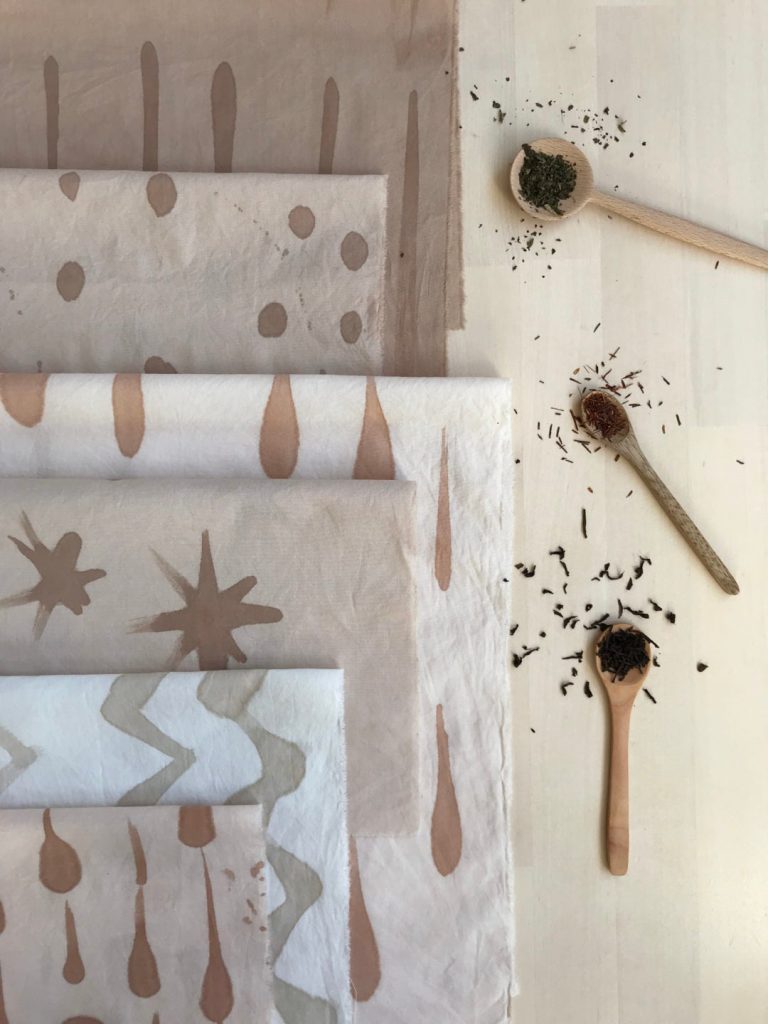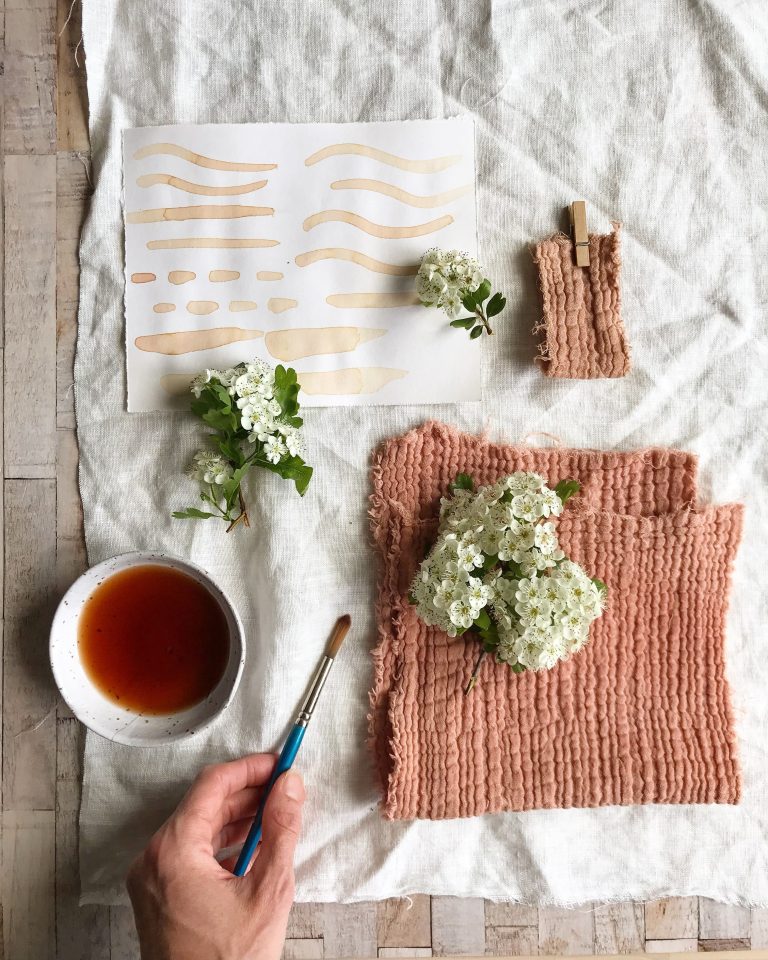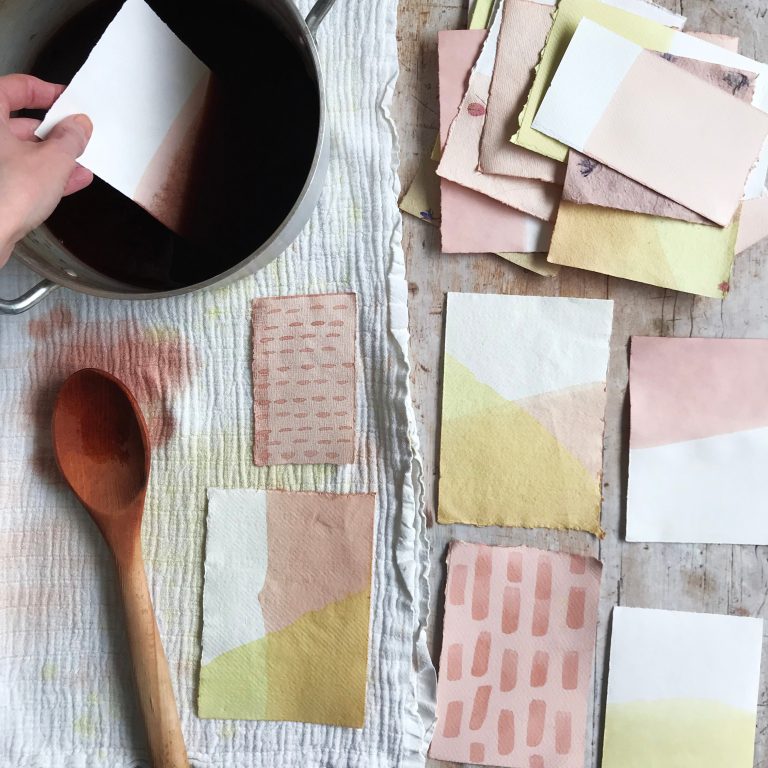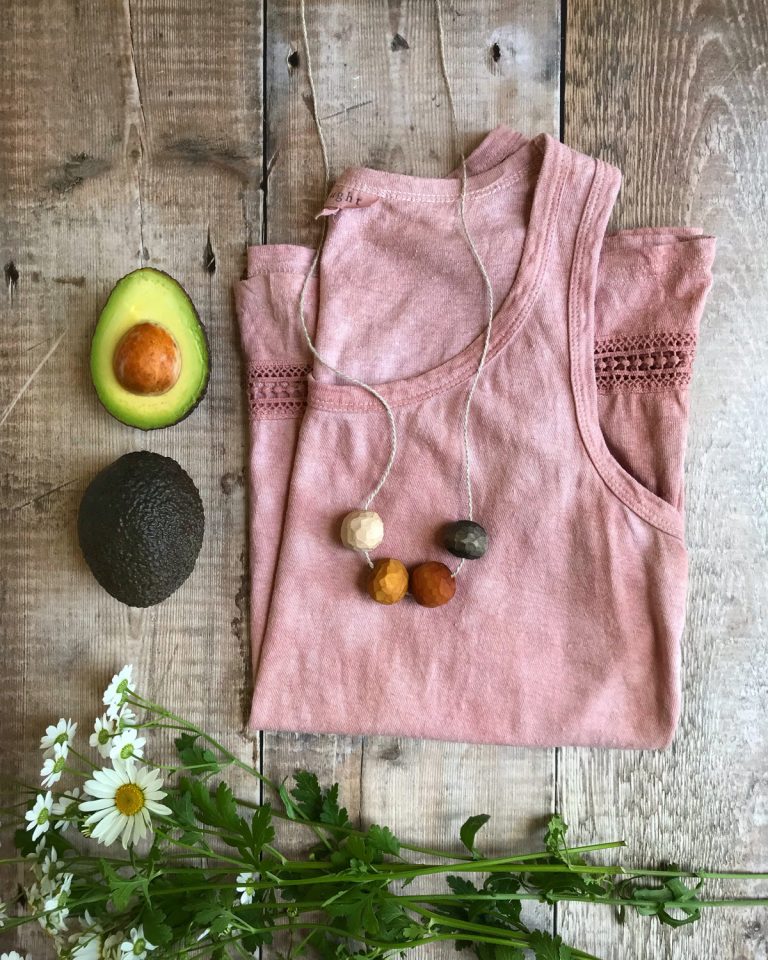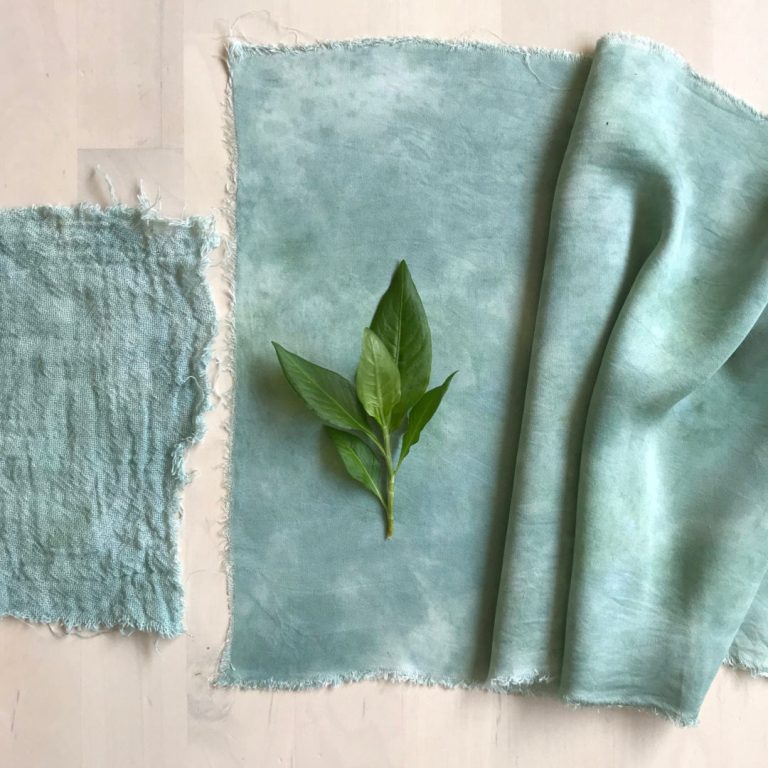If you’ve read Botanical Colour at your Fingertips, you’ll be familiar with pretreating fabric with soya (soy) milk. It’s a method for preparing fabric before dyeing to achieve darker colours and improve colourfastness.
The soy bean protein in the milk coats cellulose (plant) fibres which makes them act more like protein fibres, such as wool or silk. Protein fibres have a natural affinity to plant dyes and dye darker and have better colourfastness. So by treating cellulose fibres in soya milk, we can encourage our fibres to behave more like protein fibres and adopt some of their characteristics.
Botanical Colour at your Fingertips details the full method and I share a recipe for homemade milk. I often receive extra questions, so thought it was time that I wrote a blog post with some FAQs. I hope that the following notes are helpful to you.
1. What’s the difference between soya and soy?
In the UK we say “soya” and this means the same as “soy” in the USA. It’s milk made from soya (or soy) beans. We are specifically making use of the soy bean protein in the milk to coat fibres.
2. Is soya milk a mordant or a pretreatment?
Let’s begin with the definition of a mordant. According to the Collins dictionary, a mordant is “a substance used in dyeing to fix colours”. Typically, within the specialism of natural dyeing, a mordant is accepted to be a substance that creates a chemical bond between the fabric and dye, such as a metallic salt e.g. aluminium acetate or aluminium potassium sulphate (both forms of alum) and ferrous sulphate (iron). Metallic salts are chemical binding agents.
If we go back to the definition of a mordant as “a substance used in dyeing to fix colours”, we can see that this description does apply to soya milk, as this is exactly what the soy bean protein does: it is used to fix colours. It must be noted that soy bean protein forms a physical bond between fibre and dye, and not a chemical bond. The protein literally coats and “sticks” to the fibres, and the dye particles attach to the layer of protein.

above: dried soya beans, soaking soya beans, and homemade soya milk. Photo from Botanical Colour at your Fingertips
In Jenny Dean’s book, Wild Colour, it states:
“A mordant is a substance that has an affinity with both the materials to be dyed and the natural plant dye stuff. Acting as a bond between the two, a mordant helps the dye to become permanently fixed to the fibres”.
– Dean, Jenny. 2010. Wild Colour, Octopus Publishing Group, page 36.
Going by this definition, we can say that soy bean protein does form a bond between the fabric and dye plant, therefore fulfils this definition of a mordant. As mentioned above, the difference between metallic salts and soy bean protein, is that metallic salts form a chemical bond, but soy bean protein forms a physical bond with fibres.
Many natural dyers define a mordant as a fixative that forms a chemical bond, and in this case, soya milk cannot be classed as a mordant in the same way as a metallic salt, as the soy bean protein doesn’t form a chemical bond. It just depends on your definition of a mordant.
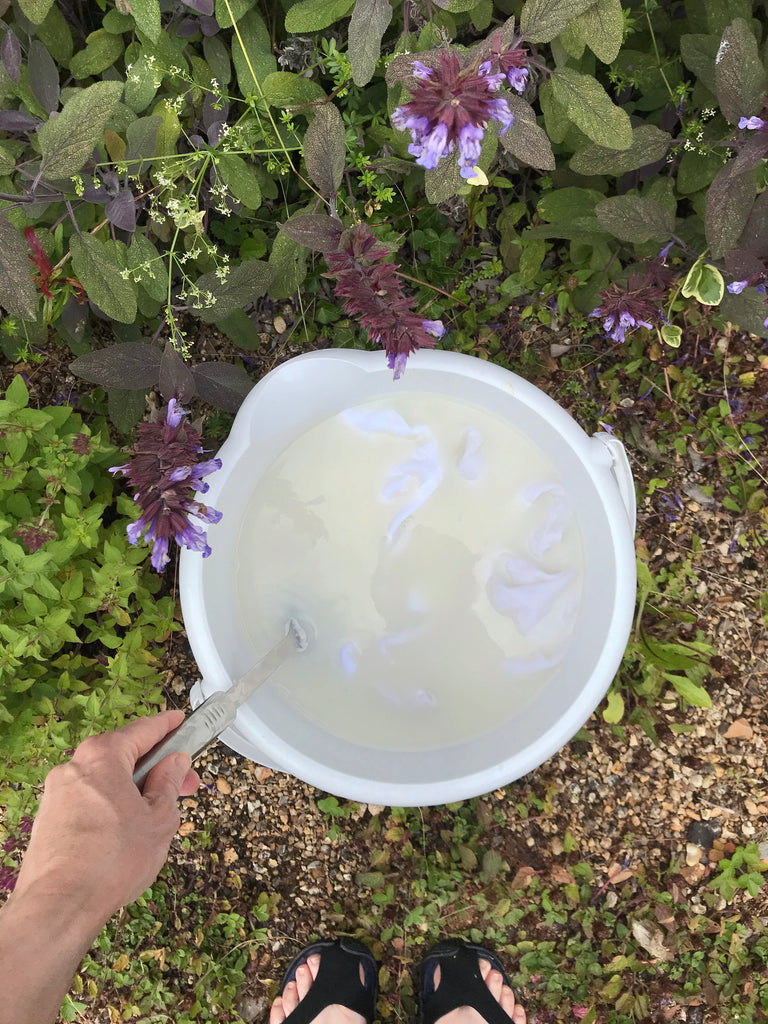
3. How long should I dip the fabric into the bucket of milk?
After the initial long soak in the milk (12 hours), the subsequent dips should be brief – just long enough to thoroughly coat the fibres. Dry the fabric between soaking and dipping. The aim is to build up thin layers of milk on the fabric.
4. What kind of fabric is suitable for pretreating in soya milk?
I work with cellulose (plant) fibres so my experience is working with these. The soy bean protein coats the cellulose fibres, thereby making them behave more like protein fibres. However, other dyers have particular uses for soya milk with animal protein fibres too.
5. Can you use normal soya milk from the supermarket?
Yes, you can simply use pre made milk from the supermarket. If possible, try to find one with as few additives as possible – ideally just soya beans and water. However, if you cannot find one like this, then it’s not the end of the world, so use what you can.
When I don’t make my own milk, I like to use soya milk available in the UK made by Plenish which is filtered water and 8% organic soy beans. The tetrapack (carton) is widely recyclable now, so I don’t feel guilty buying milk on occasions. It is very convenient to have a small stock in the cupboard. For larger projects, it’s more affordable to buy dried beans and make your own milk.
6. Is it necessary to use soya milk even when dyeing with tannin rich dyes?
Not always, but I’ve found that soya milk helps achieve darker colours no matter what dye you use. If you’re happy with a paler colour on your cellulose fibres, then try a tannin rich dye on untreated fabric. You can always go back and pretreat in soya milk later on, then redye the fabric to get a darker colour.
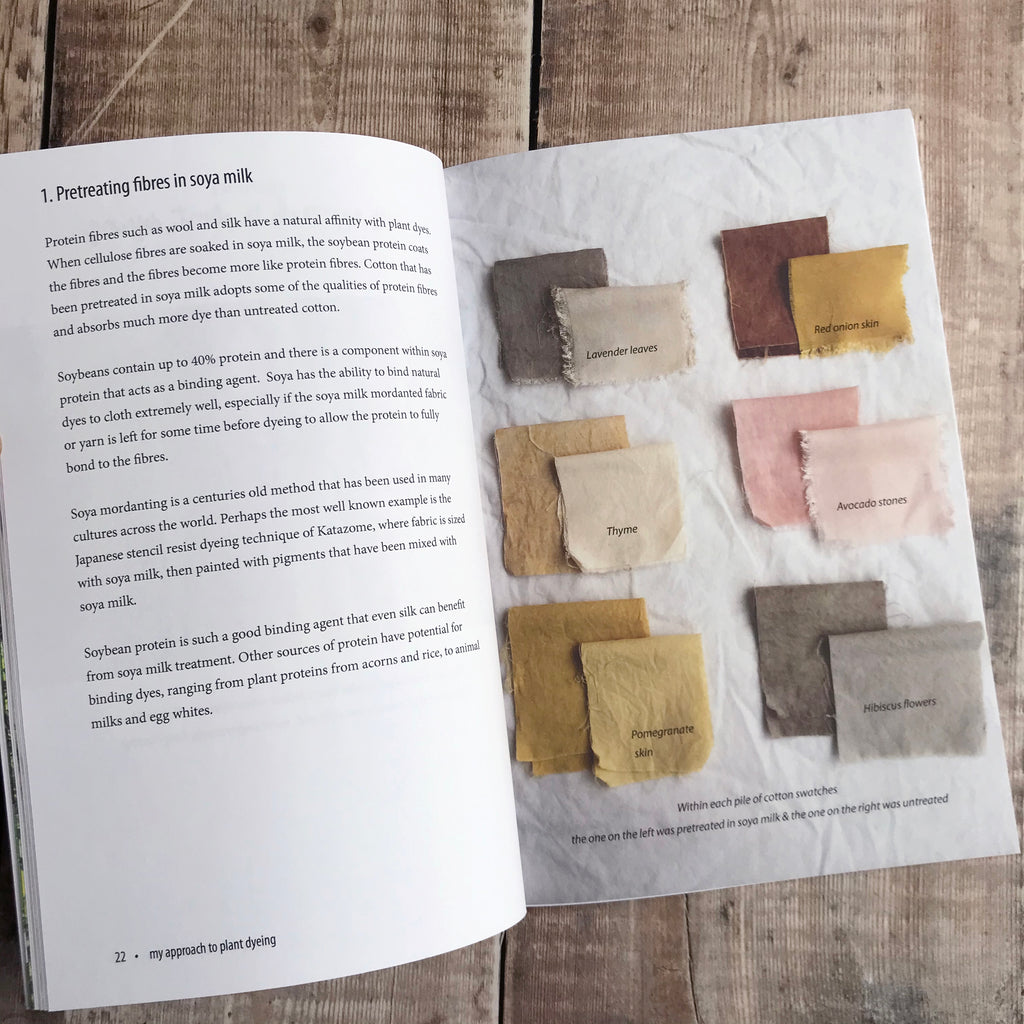
7. How much milk and water is needed for ‘X’ amount of fabric?
I use a 1:5 ratio of milk to water, and simply scale this up depending on how much fabric I am pretreating. Fill a bowl or bucket with as much liquid as you think you need, roughly keeping to the 1:5 ratio. When you do the initial long soak, you need to make sure that there’s enough space for the fabric to be stay submerged. If necessary, top up with a little more water just to ensure that all the fabric is under the water level.
8. Can I wait a few weeks/months before dyeing my soya milk pretreated fabric?
9. What if the milk ferments? How fermented is too fermented?
I always discard the milk the moment is begins to curdle. At this point it begins to smell, and the smell on the fabric is very unpleasant. It can also cause uneven patches on fabric. When you use fresh milk, there is no smell on the fabric and the layers are thin. If you happen to accidentally use fermented milk, I recommend putting the fabric through a rinse cycle in the washing machine to remove any lumpy bits of milk and to remove the smell, then either start the process again with a long soak, or pick up where you left off with a short dip in diluted, fresh milk.

10. I like to use cows milk and it works well. Why did you choose to use soya milk?
Yes, that’s right – lots of other types of milk work well. In fact anything that contains protein should work. I initially started using soya milk as it is a very old way of preparing fibres for dyeing. I’m not a scientist, but I understand that soy bean protein has special properties that mean it works particularly well as a binding agent. For this reason, it has been used as part of the natural dyeing process for a long time. I’ve tried other plant milks too – for example, almond milk worked well, although I haven’t used it as extensively as soya milk. The best thing is to test your chosen milk on smaller pieces of fabric and see if you’re happy with the depth of colour and colourfastness.
11. Can I reuse a bucket of milk for more fabric?
Yes, if there’s any milk left, then you can add more fabric, but you’ll be up against the clock as it might begin to ferment. You don’t want the milk to curdle with fabric in there as it will smell and the finish will be uneven. If you can store the milk somewhere cool, ideally in a fridge, this will extend the time you have.
12. Sometimes I find that the dye is patchy. Is this due to the soya milk?
If the milk begins to curdle and you continue dipping the fabric in there, then the layer of milk applied to the fabric won’t be thin and smooth. You may end up with some thicker areas, and perhaps some actual chunks of thick milk will settle on the fabric. You do not want this to happen as it will give an uneven dye result. If your fabric is in the bucket of milk when it begins to ferment, I suggest putting it through a wash cycle in the washing machine, then picking up the process with fresh milk.
Thanks for reading!
I hope that some of these points have been helpful to you! I will continue adding to these FAQs over time, so please get in touch if you’d like to ask a question and I will do my best to help.


